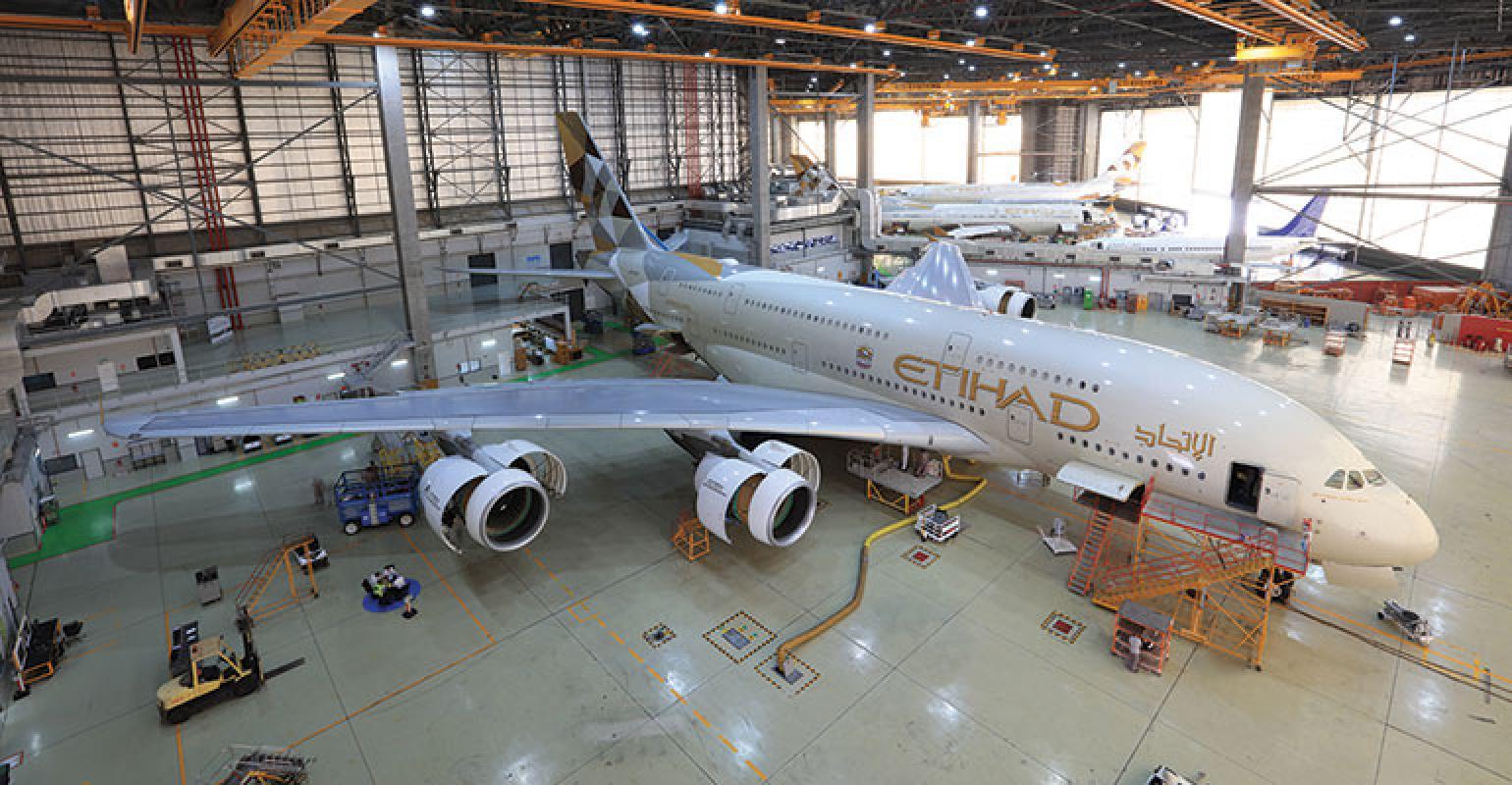
Credit: Etihad Airways Engineering
Etihad, which operated 10 A380s pre-crisis, sent the aircraft for long-term storage in Europe earlier this year. Adding to its uncertain future in its fleet, the airline's CEO Tony Douglas stated that he didn't see the superjumbo as commercially viable.
Before the pandemic crash, one of the hottest topics in MRO was 3D printing of plastic replacement parts for cabin interiors by MROs. While the traffic slump and cash crunch slowed down efforts on many innovations, progress has continued in this promising area.
For instance, working with the 3D specialists at EOS, Etihad Engineering has now qualified over 15 part numbers, of which at least half are very common in Boeing and Airbus fleets, according to Ahmad Al Rajei, acting vice president design, engineering and innovation.
These parts include seat escutcheons, crash-axe covers, wall plugs, seat-cup holders, seat-link covers, cable shroud boxes and seat locators. Further, “We have printed and sold more than 10,000 parts flying on Middle East, South American and European operators,” Al Rajei notes.
Benefits have been significant. 3D printing is up to 25% cheaper than pricing on OEM replacement parts, and, with an average of 14 days in production, lead times for obtaining parts have been reduced nearly 90%.
Although Etihad’s primary partnership is with EOS, and the MRO hopes to build on this partnership where possible, it has been approached by several other 3D printing manufacturers and is still evaluating what working with other companies partnerships might offer.
And the Middle East shop’s design team continues to evaluate more parts for 3D printing, as do its customer airlines. Etihad has already 3D-printed a critical prototype part, and the part is currently being evaluated and live- tested at the customer operator’s base in Germany.
Al Rajei says his main challenge is to reengineer a part without replicating its weak points. “We don’t want to make a one-to-one replacement. We want the part to last longer, at least until the next cabin refresh or through the lifespan of the aircraft.”
That might not be regarded as an ideal business model -- making a part that does not break – for a business that makes money by repairing parts. But Etihad takes pride in this approach, and, over the long run, customers will pay for more durable parts.
And Al Rajei says durable 3D-printed parts might be part of an airline’s carbon-offset program as they last longer than normal plastic parts.
To date, the MRO has used selective laser sintering and fused deposition to print parts. But the Etihad engineer anticipates more 3D technologies will be developed and easily meet regulatory requirements. “Stereo-lithography and digital light printing will be part of almost all MROs’ and aircraft operators’ businesses in years to come.”
At Magnetic MRO, interior project manager Pärtel-Peeter Kruuv has been focusing on next-generation cabin products. Magnetic has partnered with Baltic 3D in Latvia, which has experience in 3D printing with several industries and is located nearby.
In the wake of the pandemic, Kruuv is emphasizing higher levels of hygiene in printed parts. “We see that 3D printing allows us to easily incorporate antibacterial surface-finish solutions and materials throughout the passenger cabin.” And additive technologies allow Magnetic to develop parts that can neatly fit into existing lavatories, keeping implementation costs reasonable.
Kruuv argues 3D printing of plastic interior parts is the perfect technology for aviation, given that aircraft need enormous numbers of parts, spares are continually needed, weight is critical and aircraft last so long in service.
He predicts that 3D printing will move beyond just spares to improving line-fit parts. “I believe we’ll start to see situations where low-risk items such as various linings and shrouds in cabins, which were initially made using traditional technologies, are replaced with better parts printed by OEMs, third-party suppliers or even MROs, with necessary permissions.” The current financial pressures on airlines might prompt a look at this potentially cost-saving approach.
Kruuv says one major hurdle to expanded 3D printing is simply limited knowledge. For example, “how things are designed, when it’s reasonable to just measure something up with a caliper, when to use a specialized coordinate-measuring machine or when to use 3D scanning, all this needs to be understood before anything can be printed.”
Developers also need to understand when printing makes sense at all and how to overcome current limitations on 3D technology. Expertise in these areas is still confined to a small group of 3D enthusiasts in aerospace, Kruuv says.
Fortunately, familiarity with 3D is spreading. High-quality hobbyist printers can now be bought for 250€, which encourages the spread of knowledge about 3D.
But Kruuv still sees a lot of skepticism about certification of 3D parts. And he fears that over-engineering implementation of newly designed 3D parts will diminish the rapidity of 3D printing -- one of its chief attractions.
So the Magnetic manager foresees a gradual shift of mostly low-stress components from traditional manufacturing to additive manufacturing over the next ten years, but not complete replacement of traditional injection-molded, extruded or milled components.
He also predicts that cabin interiors will have fewer aluminum and composite-honeycomb structures, as better stress-simulation software and material science brings better materials to cabins. That could open up more opportunities for 3D.





